Cathedral Valley Drive and Exploration
Capitol Reef NP - April 6
It was crisp and cool in the pre-dawn dark of our little tent spot near Torrey. Today was our last day of exploring before returning to SLC and getting ready for our (well, for Jenn and I at least) flight back to Ottawa. We solidified our plans to make an exploratory journey across the extreme northern part of Capitol Reef National Park.
The northern reaches of Capitol Reef National Park is usually referred to as Cathedral Valley, but that area is but one of several broad areas that collectively make up the park's northern tip. There are a few access roads, all of which are long and unpaved. The two most commonly used ones head north from near the Fruita area, along highway 24. However, one of these roads required a ford of the Fremont river, and it was much too early to get a report from the park's visitor center. And since I wanted something better than a there-and-back drive, I considered some of the other access roads that were available to us.
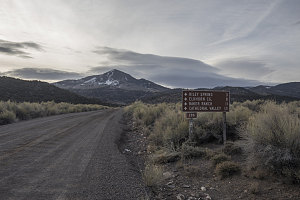
Backway to Capitol Reef
We soon settled on a forest service road (FR206) in nearby Fishlake National Forest. Based on the information we had in maps and from the 'net, it seemed like it would work. The only potential fly in the ointment was that the terrain in that part of the National Forest was quite high - between 9 and 10,000 feet above sea level - and I wasn't 100% sure that the winter snows were melted enough to make passage possible. It *seemed* from all of the information that I could glean that it was probably ok.... but the only way to know for sure was to actually go and try. And if it wasn't passable, it would be a sizeable waste of time. Fortunately, Torrey wasn't that far away from this forest service road (our re-positioning from the day before had helped with that), so it was worth a shot. And it was also why we were up so early.
We arrived at the start of FR206 at about 7:50 a.m. Already the elevation was nearly 8200 feet, and I was glad to see that there were no patches of snow anywhere to be seen on the ground. The highest terrain and peaks in the area were definitely snow covered, but I was much more hopeful now that the road (which led over a high, broad pass) might be clear.
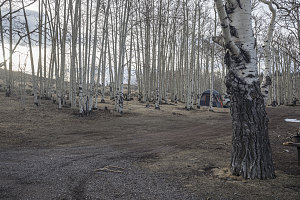
Riley Springs
We drove uphill through the forests and meadows of the National Forest, watching our altimeter steady climb while at the same time looking outside for signs of snow. We passed through some very pretty all-white birch forests, branches denuded of leaves and patiently waiting for the arrival of spring (which is of course quite a bit later at this high altitude).
As we passed the beyond the 9000-foot mark, the forests increasingly gave way to large sub-alpine meadows and, indeed, a few patches of snow here and there.
The road was also flattening out, though, as we neared the broad pass that would give us access to the slopes leading down to northern Capitol Reef. So far, no patches of snow had covered the road. It looked like it was going to work out for us!
Over the height of land we went, following some helpful signs that switched us onto various other forest service roads in the direction of Capitol Reef (the way to Capitol Reef was specifically signed). We began to descend, crossing through one steeper area of road through heavier forest that actually did have a bit of ice and snow on it (but fortunately not enough to be troublesome). Off into the distance, we could see some very interesting looking desert scenery - likely the landscapes of Northern Capitol Reef.
Our choice to take this northern route into the park had worked out extremely well, and we arrived at a marked northern entrance into Capitol Reef only 45 minutes or so after turning off of Utah Highway 72.

Entering northern Capitol Reef
We were in a fairly good location, coming in where we did, and were fairly close to many of the notable attractions in this extreme northern end of the park. There are various overlooks into the two main topographic regions, and since it was nice and early, we'd be able to visit nearly all of them.
First up was a visit to an overlook over Upper Cathedral Valley, via a very short access trail. Cathedral Valley is the signature feature of the northern part of the park, and it did not disappoint: from an amazing and airy little peninsula at the end of the trail, we looked out over a cedar-dotted grassland (known as the Middle Desert), interrupted down the middle by a line of beautifully-fluted sandstone towers - the so-called "Monoliths" (or, alternatively, as Cathedral Mountain). A line of similiarly-fluted cliffs ringed the whole area, forming the perimeter of the valley. And there were no other cars or people visible. We seemed to have the place to ourselves.
Upper Cathedral Valley Overlook Trail
We spent quite a bit of time trying to photographically capture the beauty of the place. Eventually we did see some signs of other human life - a couple of SUVs trailing a group of mountain bikers heading down the park road that winds through Cathedral Valley.

courtesy BConnell
Upper Cathedral Valley Pano
Brian, Upper Cathedral Valley
Jenn and Brian at Overlook
Eventually we tore ourselves away from the beautiful overlook, returning to the trailhead to decide what to visit next. Based on proximity, that seemed to be an overlook over the Upper South Desert, which was only a few bumpy road miles away from where we were.
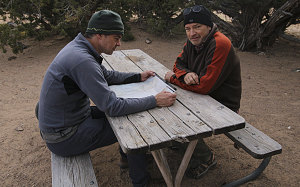
courtesy JInnes
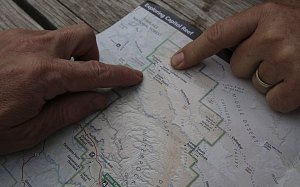
courtesy JInnes
Upper South Desert Overlook trail
Again, the trail was short and the payoff high: only a few hundred yards brought us to the edge of an escarpment looking over the Upper South Desert, a huge wide basin that stretched away to the south. The right side of the basin was formed by the northernmost beginnings of the Waterpocket Fold. We had truly had a thorough look at Capitol Reef and the fold on this trip - from all of the way in the far south, along Halls Creek, up to where we were now. Somewhere around 100 straight-line miles of distance from here to there.
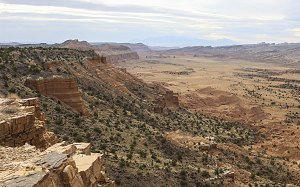
courtesy JInnes
Head of Upper South Desert
A couple of nearly detached towers jutted out into the basin, and the overlook trail headed over the top of them, ending in a wide, expansive view of the whole basin. Off in the distance we could see a line of small dark knobs; they looked volcanic, possibly related to the volcanic intrusion that we noticed under the very tower we were standing on.
After finishing up with the Upper South Desert overlook, we headed a short distance back the way we came and then started down the Cathedral Valley Road (one of two main north-south roads that connect this northern area with the more visited Torrey-Fruita-Hanksville corridor). After a very slow and bumpy descent down into the bottom of Cathedral Valley's basin, the road became rather tame - soft and fairly smooth.

courtesy BConnell
Cathedral Valley Campground
Bathrooms at CV Campground
We stopped to visit several attractions along our drive southward along Cathedral Valley Road: an old historic line cabin (very well preserved), a close-up view of the Monoliths of Cathedral Valley, and the weird Sandworm-like (as in Frank Herbert's Dune) hole that is known as the Gypsum Sinkhole. In addition to the amazingly beautiful sedimentary geology of Cathedral Valley, we encountered some really interesting and well defined intrusive volcanic features. There was an excellent dike right around the intersection of Cathedral Valley junction - a dike that extended for quite some distance in either direction, too.
Side Trip to Morrell Cabin
Interpretive Plaque for Cabin
Driving through Upper Valley
Brilliant, Bold Landscape